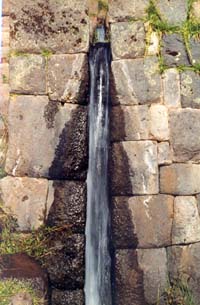Archaeohydrology
 |
Archaeohydrology is the study of the water management practices of early cultures. The archaeological site of Tambomachay is located north of the city of Cuzco,
in the southern Peruvian highlands. The well-crafted stonework, beautiful fountains, and pastoral setting on the Cachimayu ("Salt River") combine with ease of
access to make this site one of the most visited in the area. High quaility stonework, a double-jam doorway, and large, outward-facing niches all indicate that
the site was an important shrine to the Inkas. Despite the importance of the site, the original name is uncertain. Cobo (1653) tells us that Tambomachay was a
house, yet there is no provision for lodging at the present day archaeological site. It is likely that the original name was "Quinoapuquiu". Cobo tells us that
Quinoapuquiu "...was a fountain near Tambo Machay which consists of two springs."
The hydrologic nature of Tambomachay captured Dr. Fairley's interest during a visit in 1995. Since that time he has been studying the hydrogeology of Tambomachay and other Inka sites. Understanding Inka water management practices requires a knowledge of Inka culture, as well as a good background in hydraulics and geology. The result is the opportunity for archaeologists and hydrologists to work together and learn from each other. For more information, contact Dr. Fairley at jfairley@uidaho.edu. |







